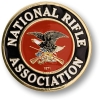-
FREE MEMBER
NO Posting or PM's Allowed

Reloading Question for AR / 223 brass
I'll be reloading for 223 for the first time and I'll be using LC brass. My question - is military brass in 223 thicker walled like 30-06 - do I need to
lower powder charges from my manual because of case capacity or are the brass dimensions the same between military and commercial brass in 223.
thanks a bunch all
Information
 |
Warning: This is a relatively older thread
This discussion is older than 360 days. Some information contained in it may no longer be current. |
|
-
07-07-2009 11:30 AM
# ADS
Friends and Sponsors

-
Legacy Member

depends
some military brass is "thicker" some isn't. If your military brass weighs in the range of 88-92 grains each, forget it. As for "reducing" a charge to compensate for any difference, if you are loading a heavy bullet at near max, sure, reduce 10% and check your brass, If you are not loading near max and/or using heavy bullets, I PERSONALLY would not.
-
-
FREE MEMBER
NO Posting or PM's Allowed

Get a few reloading manuals and read their suggestions about military brass.
They almost uniformly suggest starting low, about 10% under starting loads and working up to look for pressure signs and primer conditions.
My LC .223 reloads seem to work best on the light side of loads. Maybe because I am shooting 100 yards and not 1000..and don;t need a "hot" mil-spec load...maybe because the heavier LC Brass doesn't need as much for it's max load.
Whatever you decide....check the manuals, make test loads and see what works best in your AR.
Primer condition is important so study up on recognizing pressure signs/flattening.
-
John Kepler
Guest

To begin....the LC and other mil-spec brass I've loaded (with the caveat that that hasn't been much in the way of volume) has been loaded the same as the commercial Winchester I normally use without ANY noticeable difference in either loading or performance. But, Momma didn't raise no fool, and I did start the load adaption for the mil-spec brass with reduced loads. It should also be noted that even the reduced loads stayed "on-the-curve" with the commercial loads, indicating little or no difference between them and the Winchester commercial cases that generated the load-velocity curve in the first place. YMMV.
Having said that, my comp loads aren't exactly fireballs...I generally am loading to a velocity target and simply add powder until I get there or max-out the loading data, whichever comes first. My velocity targets rarely take fireballs to get there. The higher you load on the charts, the more any differences between mil-spec and commercial cases are going to show. So don't take this as gospel (Hey...it's the Internet!), simply an anecdotal data point in a LIMITED set of circumstances!
-
Thank You to John Kepler For This Useful Post:
-
Legacy Member

As you get older, you appreciate the good side of moderate loads
I'm talking about shooting loads that are 1-200FPS under max, they are easier on the brass and barrel, the overall life of the weapon, your shoulder and wallet. As long as you can stabilize the bullet out to the range you are shooting, hot loads are unproductive. The Army found that 30 cal match bullets shot best at 2600+- well below the max
-















 Register To Reply
Register To Reply






